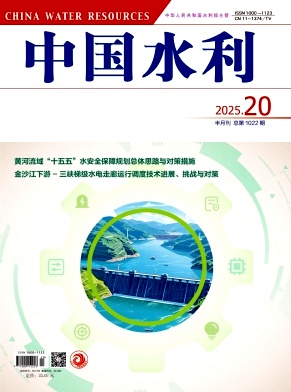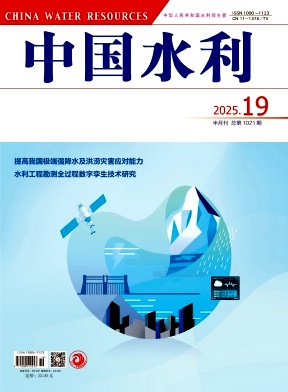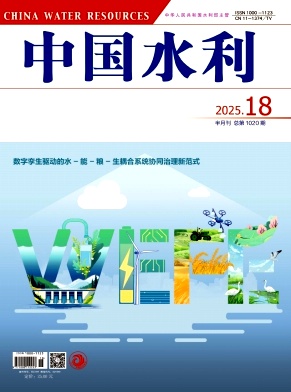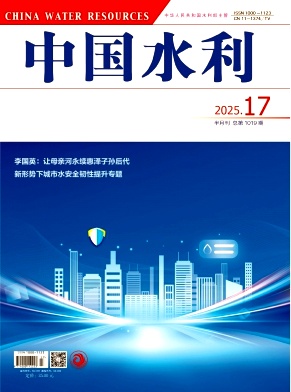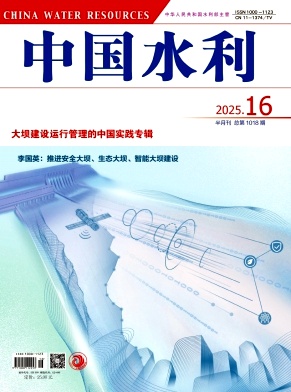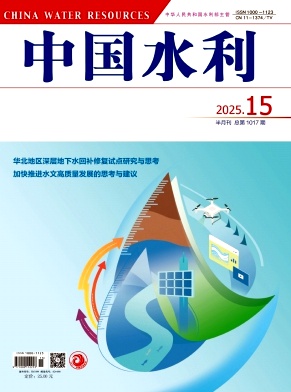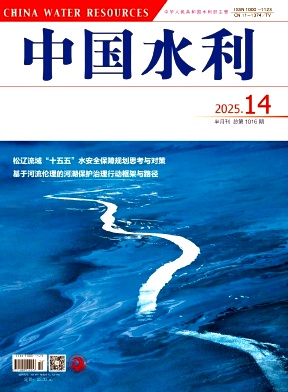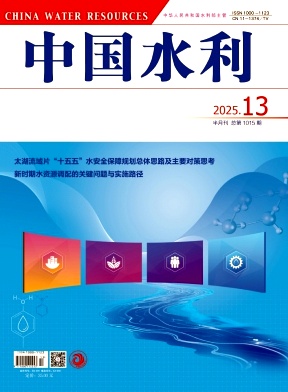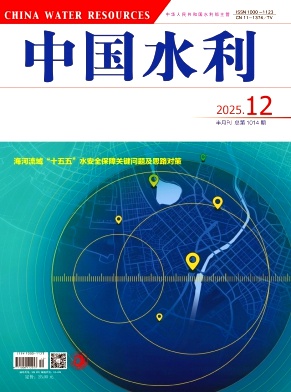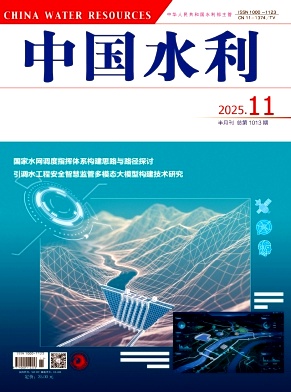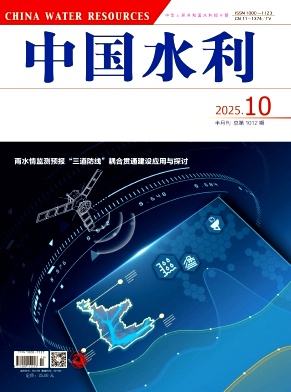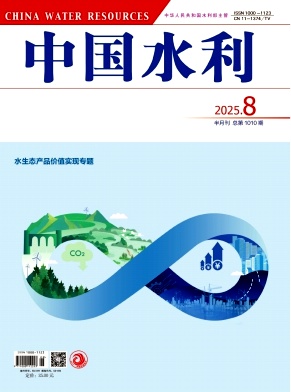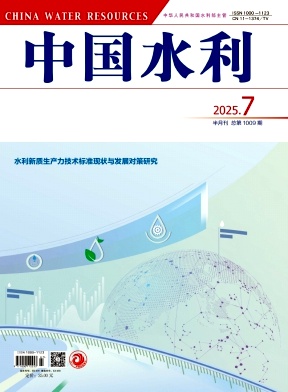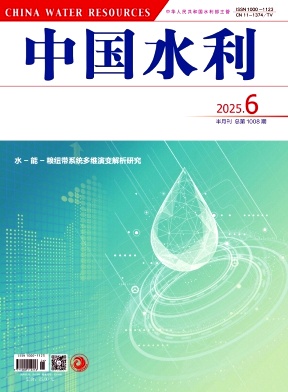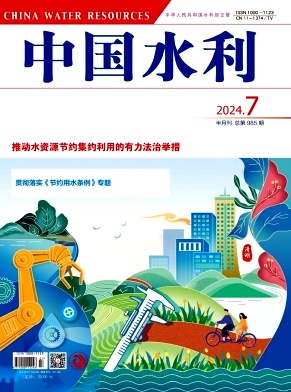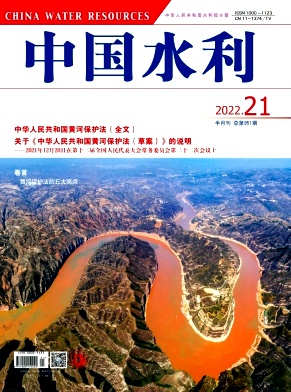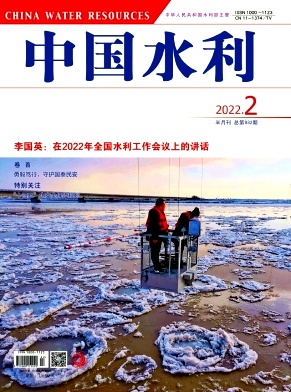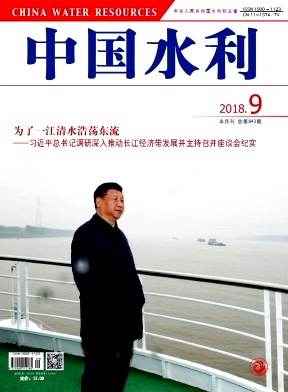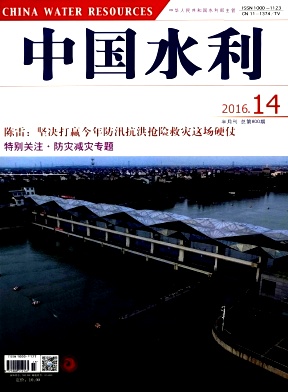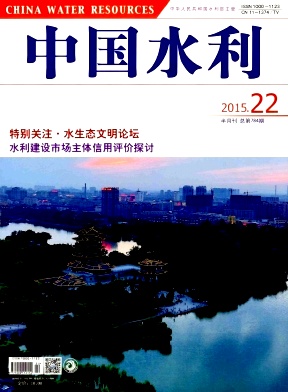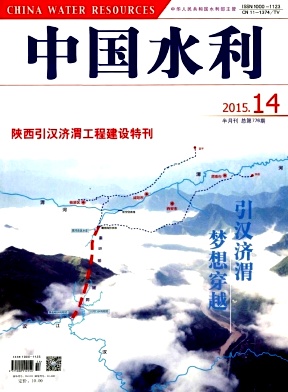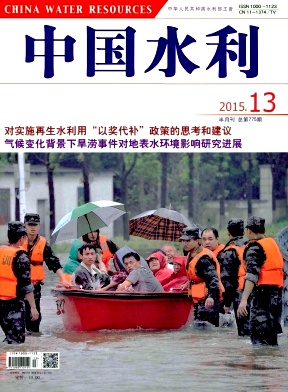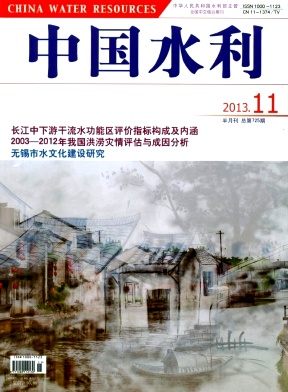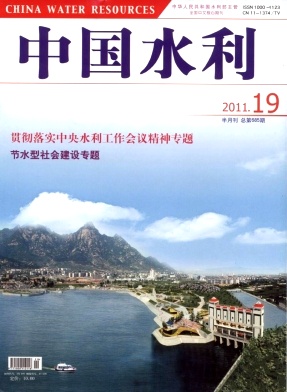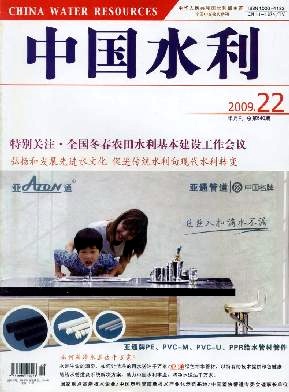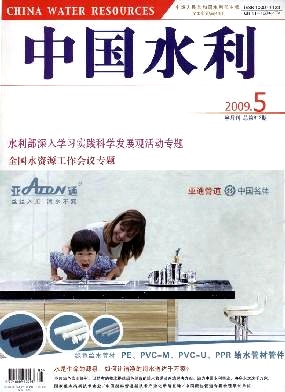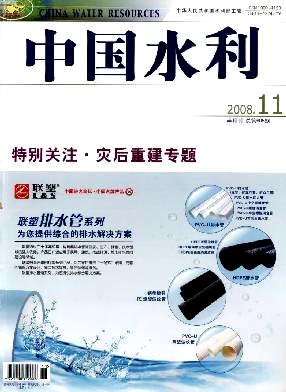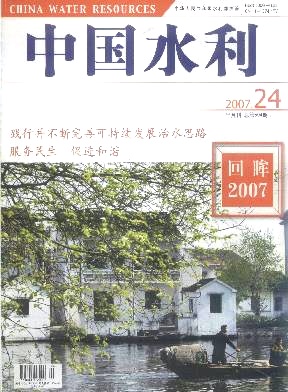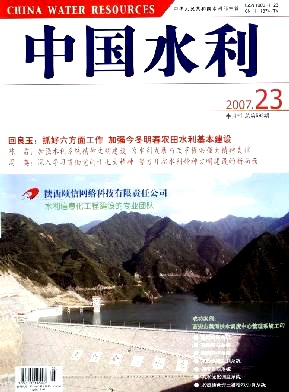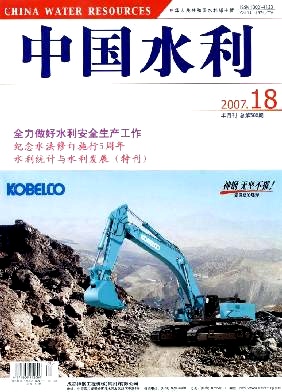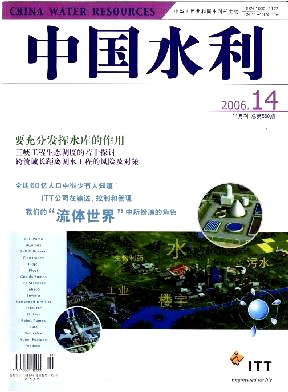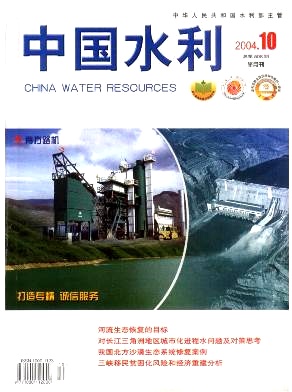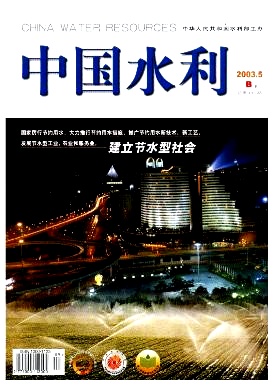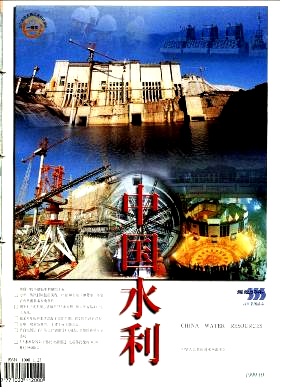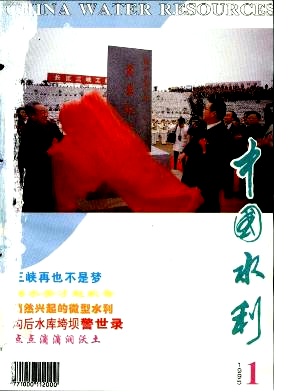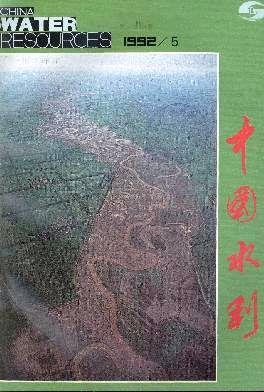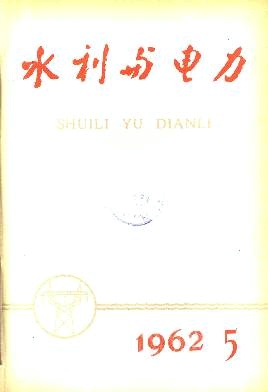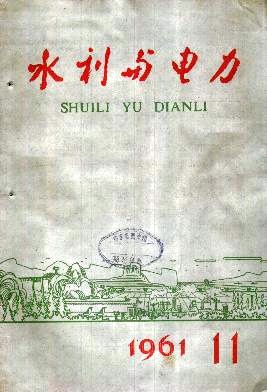Online First
Key technologies for type-selection and configuration of super-large-diameter TBM clusters in the Water Diversion Project from the Yangtze River to the Hanjiang River- SONG Zhizhong, LI Heng, SHAO Xiaokang, et al.
Application and future development of TBM in water project construction - ZHAO Yufei, ZHANG Yunpei, YANG Jianxi, et al.
Research and recommendations for improving the basic work of water rights reform - LI Guozheng, MA Suying
more..Issue 22, 2025
Accelerating the building of a modern water network - LI Guoying
Overall approach and key measures of soil and water conservation in the 15th Five-Year Plan period - MO Mo
Overall ideas and key measures for water security safeguarding plan in Zhejiang Province during the 15th Five-Year Plan period - LI Rui
more..Current situation and countermeasures for flood resource utilization in China
Expert Consultation Group on Flood Resource Utilization,Science and Technology Committee,Ministry of Water Resources;Situation requirements, ideas and measures for water security guarantee in the Yangtze River basin during the 15th Five-Year Plan period
LIAO Zhiwei;The Yangtze River is the mother river of the Chinese nation and an essential foundation for national development. Water security in the Yangtze River basin is vital to the country's long-term stability. This paper summarizes the achievements in safeguarding water security in the basin, provides an in-depth analysis of the new situation and emerging requirements, and, based on fully leveraging the guiding role of strategic planning for the water sector, proposes the overall approach for formulating the 15 th Five-Year Plan for water security in the Yangtze River basin. Guided by the “six implementation paths” for high-quality development of water sector and by the goal of accelerating the development of new quality productive forces in the water sector to adapt to major transformations in productive forces, the paper puts forward major measures for water security from six perspectives: ensuring the Yangtze River's security and stability; accelerating the development of a modern water network; comprehensively advancing the ecological protection and restoration of rivers and lakes; continuously promoting the development of the Digital Twin Yangtze River; further enhancing the intensive and safe utilization of water resources; and consistently improving the institutional, governance, and legal framework for basin management. These measures provide a decision-making basis for supporting the high-quality development of the water sector, charting a development pathway to sustain the Yangtze River's vitality, and contributing “Yangtze River Strength” to better support and serve the advancement of Chinese modernization.
Construction and management of small-scale farmland water projects:progress, challenges, and strategies
FANG Yu ;ZOU Minzhong ;WANG Sufen ;NIU Jun ;KANG Shaozhong;Small-scale farmland water projects are essential infrastructure for agricultural production and rural life in China, playing a crucial role in stabilizing and increasing grain production, ensuring rural water security, promoting sustainable agricultural development, and advancing comprehensive rural revitalization. At present, the construction and management of water projects face systemic challenges, with some regions experiencing long-term disrepair and functional degradation of facilities, which directly affect their sustainable operation and benefits. This study analyzes the progress of small-scale farmland water projects in stabilizing grain and cash crop production, ensuring rural water security, promoting green agricultural development, and advancing rural revitalization. It further examines existing problems, such as unclear responsibilities, insufficient overall planning, shortages and imbalances in construction funding, and the lack of effective management and maintenance mechanisms. Targeted measures are proposed, including clarifying departmental responsibilities, promoting coordinated planning based on local conditions, increasing investment and balancing fund allocation, systematically summarizing and promoting management and maintenance experience, and strengthening scientific and technological support. These measures aim to promote the high-quality development of small-scale farmland water projects, enhance agricultural production resilience, and ensure national food security.
Progress and prospects of comprehensive reform of agricultural water prices
WANG Huan ;LU Wenhong ;XU Lei;The comprehensive reform of agricultural water prices is a crucial measure to promote sustainable utilization of water resources, ensure the sound operation and sustainable development of irrigation districts, and safeguard national food security and water security. After years of reform results progress have been achieved and valuable experience has been accumulated. This paper briefly outlines the objectives and significance of reform of agricultural water prices, reviews its four development stages, and summarizes main achievement based on the practices and experiences of various regions over the past 10 years. Focusing on the establishment of reform mechanisms, the paper analyzes and sorts out promotable local experiences. It elaborates on the basic contents and requirements of major reform mechanisms such as water metering technology, water price formation, and project operation and maintenance, and summarizes and refines innovative measures derived from local practices to form specific approaches with guiding significance. Current challenges are analyzed, including uneven infrastructure development, insufficient supporting metering facilities, difficulties in maintaining longterm incentive and subsidy mechanisms, and inadequate grassroots management systems. Based on the current reform situation, the paper further explores the future directions of deepening the reform prices, including consolidating long-term reform mechanisms, promoting the modernization of irrigation districts through digital technologies, improving water management systems based on water measurement, and establishing dynamic adjustment mechanisms for agricultural water prices and subsidies. The study aims to provide references and insights for further advancing the comprehensive reform of agricultural water prices in China.
Analysis of water and sediment changes and characteristics of the aquatic nutrient environment in the middle Yangtze River under sediment regulation
SHI Haoyang ;YANG Wenjun ;GUO Hui ;CAO Huiqun ;HU Man ;ZHU Xinxin ;BAO Chengcheng;The joint regulation and operation of the Three Gorges Project and the cascade reservoirs upstream have altered the processes of water and sediment transport in the middle and lower reaches of the Yangtze River. The combined hydrodynamic effects of clear-water discharge and the inflows from major tributaries and lakes in the middle reaches have reshaped the nutrient environment pattern of the river. Based on systematic monitoring during the complete hydrological cycle from 2023 to 2024, this study reveals the spatiotemporal evolution of sediment characteristics, nutrients, and dissolved organic matter(DOM) in the river section from Yichang, Hubei to Jiujiang, Jiangxi. The results show that reservoir regulation significantly changed sediment composition characteristics. During flood discharge, the proportion of silt particles sharply increased to 95.2%, and the median sediment particle size exhibited spatial variation ranging from 3.2 to 59.5 μm. Tributary inflows made significant contributions to local clay enrichment. The coupling of water and sediment had selective effects on nutrient migration and transformation: very fine sediment markedly enhanced the adsorption capacity for phosphorus; dissolved silicate showed a significant positive correlation with sediment content; while nitrogen distribution was mainly controlled by human activities and showed a weak correlation with sediment characteristics. DOM components displayed clear seasonal succession characteristics, with microbial-derived humic acids dominating during the non-flood season, and additional terrestrial fulvic acids and other characteristic humic substances-emerging during the flood season, increasing the number of DOM components from 2 in the non-flood season to 4 in the flood season. The study elucidates the synergistic variation characteristics of the “water-sediment-nutrient-organic matter” system under the regulation of the Three Gorges Project system, providing a scientific basis for ecological protection in the middle and lower reaches of the Yangtze River.
Key technologies for type-selection and configuration of super-large-diameter TBM clusters in the Water Diversion Project from the Yangtze River to the Hanjiang River
SONG Zhizhong;LI Heng;SHAO Xiaokang;NIU Yunhua;ZHU Xuexian;LI Yashi;The Water Diversion Project from the Yangtze River to the Hanjiang River is an important component of China's national water network construction. It includes the country's longest single tunnel with the largest diameter and the highest overall technical difficulty among pressurized water-conveyance tunnels under construction. For the first time, a cluster of super-large-diameter tunnel boring machines(TBMs) has been applied in the project, breaking through the technical limitations of TBM type-selection and configuration for hydraulic tunnels in China. In the TBM cluster type-selection study of the project's water-conveyance tunnel, quantitative selection methods were applied, including threshold analysis of adverse geological conditions and fuzzy comprehensive evaluation of TBM adaptability to deep composite strata. Based on a comprehensive evaluation of geological and structural adaptability, safety, economy and schedule reliability, a cluster scheme comprising 4 open-type, 3 single-shield, 2 double-shield and 1 dual-mode TBMs was proposed. Meanwhile, several innovative technical systems were configured, including the open-type TBM steel segment erection system, the normal prestressed anchoring drill rig, the double-shield TBM anchor-mesh-shotcrete support system, the advanced geological prediction system, the multifunctional forward-probing drill system, and the intelligent TBM cluster management and control platform. This approach establishes a new model for the type-selection and targeted configuration of super-large-diameter TBM clusters in deep-buried, long-distance tunnels under complex geological conditions.
[Downloads: 31 ] [Citations: 0 ] [Reads: 0 ] HTML PDF Cite this article
[Downloads: 63 ] [Citations: 0 ] [Reads: 0 ] HTML PDF Cite this article
[Downloads: 283 ] [Citations: 0 ] [Reads: 0 ] HTML PDF Cite this article
Pilot studies and reflections on deep groundwater recharge and restoration in North China
Overdraft of confined deep groundwater remains a serious issue in North China, where natural recovery is difficult due to limited recharge and slow renewal of deep aquifers. This has led to the long-term existence of groundwater depression cones, further triggering a series of ecological damages and geological hazards such as ground subsidence and seawater intrusion, exerting ongoing impacts on regional production, livelihoods, and ecological security. To address the groundwater depletion caused by long-term overdraft, a coordinated “point-line-area” approach and a comprehensive governance and restoration model integrating “suppression, recharge, and reinjection” have been proposed. This paper introduces the conditions and progress of recharge experiments conducted at four established pilot sites, and summarizes the findings and outcomes of a series of thematic studies carried out in conjunction with these recharge trials. Existing challenges of the pilot projects are identified, including short experimental durations,insufficient research, unoptimized water sources, and the need for improved test site conditions. In response, several targeted recommendations are proposed: extending the duration and depth of experimental studies, optimizing recharge areas and water sources, advancing research on anti-blocking and permeability-enhancement technologies,strengthening scientific and technical support, evaluating recharge effectiveness, improving research platform infrastructure, and increasing dedicated financial support, aiming to provide experiences for systematic recharge and restoration of deep groundwater and ensure sustainable utilization of groundwater resources.
[Downloads: 150 ] [Citations: 0 ] [Reads: 0 ] HTML PDF Cite this article
Construction of spatiotemporal multi-source and multi-scale fusion framework based on digital twin data base of irrigation districts
Guo Biaobiao;He Linhua;Huo Hongxu;Zhu Qianqian;Pang Zhiping;To address issues like varied data types, inconsistent formats, differing monitoring frequencies,mismatched geographic spatial scales, overlapping business domains, and diffculties in data fusion, this study proposes a framework and methodology for multi-source data fusion in the digital twin base of irrigation districts. The multi-source data fusion paths are elaborated from several perspectives, including integrating unifed water resource object models, object fusion(fusion of entity object relationships, oblique photography models and BIM models, vector objects and oblique photography models), feature fusion(integration of features from multi-source remote sensing data, fusion of terrain features at different resolutions), and numerical fusion(merging station monitoring data, spatial scale fusion of point and grid data, and spatiotemporal interpolation fusion of long-, medium-, and short-term rainfall grid forecast data). In the application of the Ouyanghai Irrigation District project, scenarios such as crop planting area estimation, drought monitoring using multi-source data fusion, and inundation analysis based on multi-source data fusion were implemented. These applications enable the digital twin irrigation district to achieve multi-level visibility, usability, and traceability,transitioning from overall to local perspectives, from abstraction to detail, and from two-dimensional to threedimensional representations.
[Downloads: 375 ] [Citations: 0 ] [Reads: 0 ] HTML PDF Cite this article
Water Rights and Water Markets: Discussing Economic Means for Achieving Optimal Allocation of Water Resources
Wang ShuchengThis article serves as a speech outline prepared for the 2000 annual conference of the China Institute of Water Resources. On March 30, 1999, during the Seventh National Congress of the China Institute of Water Resources, I presented the viewpoint of "transitioning from engineering water resources to resource-based water resources." That speech cannot be considered a purely academic theoretical article; rather, it was a set of requirements for water resources work based on the practical development of water resources. It aimed to initiate a major discussion on "how China's water resources should face the 21st century" and fulfilled my responsibilities as a leader. Similarly, "Water Rights and Water Markets", although discussing issues of water economics, does not make me an expert in this field. Instead, the urgent demand for the reform and development of water resources in China requires us to research and address such topics. I have merely laid the groundwork to draw attention to this issue.
The Outline of the 14th Five-Year Plan(2021—2025) for National Economic and Social Development and the Long-Range Objectives Through the Year 2035 of P. R. China
[Downloads: 4,359 ] [Citations: 414 ] [Reads: 6 ] HTML PDF Cite this article
Analysis of Water Supply and Demand in 21st Century China: Ecological Water Conservancy Research
Liu ChangmingFacing the resource and environmental challenges in 21st-century China, the issue of water is particularly severe. Scarcity and wastage coexist; abundance and ecological imbalance coexist; contamination and poor management coexist. In fact, there are interconnected and transformative relationships among water resources, water disasters, and water environments. Water, as a core element of ecology and the environment, has positive effects when utilized efficiently as a water resource. However, fluctuations in its abundance and scarcity can lead to water-related disasters, while its quality evolution is closely related to water management and environmental protection efforts...
Speech at the Symposium on Ecological Protection and High-quality Development of the Yellow River Basin
Xi Jinping;[Downloads: 3,963 ] [Citations: 335 ] [Reads: 148 ] HTML PDF Cite this article
Objectives of River Ecological Restoration
While water conservancy engineering construction has brought significant benefits to the economy and society, it has also posed threats to river ecosystems. Reflecting on this, people have raised questions about how to restore river ecosystems to compensate for the damage. Scholars from various countries have different views and definitions regarding the objectives of river ecological restoration. Considering the national conditions of China, when researching and implementing river ecological restoration, it is essential to base the efforts on the current status of river ecosystems. Creating favorable conditions and harnessing the self-recovery mechanisms of ecosystems are crucial steps in gradually restoring river corridor ecosystems.
A preliminary discussion of the engineering ethics and advanced cultural in Dujiang Weir
Wang Zhongjing;Zhang Teng;The Chinese people has thousands years of history for water governance.The practices of water governance,utilization and management of successive dynasties have left us with rich material,institutional and spiritual wealth.In order to explore the multiple values of this world cultural heritage,discussions are made on the contribution of those outstanding water projects represented by Dujiang Weir,so that Chinese wisdom and China's plan can be developed to address issues of imbalance between water supply and demand and other water crisis.Eco-friendly water project construction in the new age should be led by advanced water culture,with learning from good practices of Dujiang Weir from conservation and cultural prospective,so as to build a society with harmony of man and water and water structures in a modernized and eco-friendly ways.
[Downloads: 6,237 ] [Citations: 5 ] [Reads: 213 ] HTML PDF Cite this article
Human activity and the global climate change and its impact on water resources
Ding YihuiIn understanding the effect of human activity on the global climate change for recent 100 years, IPCC (Intergovernmental Panel on Climate Change) has played a key role. During 17 years from 1990, IPCC has continuously gained insight into better understanding on the global climate change during the recent 100 years mainly caused by human activity, with its four assessment reports. This achievement has been made with provision of three aspects of evidences: (1) rapid increase in greenhouse gases since preindustrial era (after 1750); (2) temperature rise or warning of surface, tropospospere and oceans; (3) 100-yr climate simulations since 1900 for detection and attribution of the past climate change. These results have shown that recent 100-yr warming is jointly caused by natural climate fluctuation and anthropogenic activity, but most of recent 50-yr climate change is caused by the authropogenic activity. The present paper has first reviewed this issue. Then, the debates and uncenrtainties of global climate change issue have been discussed. The global climate change has had a significant impact on global water resources and management. This issue is further discussed based on changes in temperature, precipitation, sea level rise and evapotranspiration, which may be a necessary scientific basis for adaptation.
[Downloads: 6,236 ] [Citations: 177 ] [Reads: 201 ] HTML PDF Cite this article
Discussions on key issues of water ecological civilization construction
Zuo QitingHow to understand water ecological civilization construction? On the basis of the interpretation of the spirit of the 18th National Congress of the Communist Party of China,this paper analyses and discusses several key issues of water ecological civilization as follows.First,the definition and connotation of water ecological civilization are given and the links between water ecological civilization construction and ecological civilization construction proposed by the state are elaborated.In addition,this paper analyses the crucial issues which should be paid attention to during the process of advancing water ecological civilization,and proposes specific recommendations to help to make the 5 goals of water ecological civilization come to be realized.
[Downloads: 5,253 ] [Citations: 248 ] [Reads: 199 ] HTML PDF Cite this article
Thought of ancient "sponge city" : experiences of applying water-adaptive landscape
Chen Yiyong;Yu Kongjian;"Sponge city" is regarded as a new approach to deal with serious ecological and environmental problems under the process of fast urbanization at present. In ancient times, we have accumulated valuable experiences of building adaptive landscapes in the process of water resources management over a long period of time and fighting against various water disasters, such as selection of site of settlement, water resources management in cities and formation of cities. This approach has reflected the thought of "sponge city" that has great significance to the design of city landscape. Research and studies on adaptive landscape in ancient cities by academic field both home and abroad in recent decades are introduced, among which the study results from the Middle East, Ancient Greece, Ancient Rome and ancient mayan civilization are plenty and most of the studies focus on water diversion and storage works. The contents and type of adaptive landscape are affected by precipitation and landscape characters. The key areas of current studies have transformed from single factors such as flood control or drought relief into comprehensive research including examining complex structure and complicated functions of water landscape. Along with development of modern technology, how to improve theories of "sponge city" construction and practice has become a key subject for modern landscape design, facing the increasingly degradation of water environment and ecosystem and the fact of heritages of water landscape in ancient cities have been damaged and disappeared with each passing day.
[Downloads: 4,427 ] [Citations: 89 ] [Reads: 202 ] HTML PDF Cite this article
The Outline of the 14th Five-Year Plan(2021—2025) for National Economic and Social Development and the Long-Range Objectives Through the Year 2035 of P. R. China
[Downloads: 4,359 ] [Citations: 414 ] [Reads: 6 ] HTML PDF Cite this article
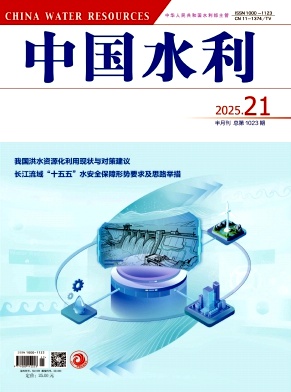
Information
Supervisor: Ministry of Water Resources of the People's Republic of China
Sponsor: China Water Resources News
Address: Room 601, IWHR Building C, No.3 Yuyuantannan Road, Haidian District, Beijing
Postal Code: 100038
Semimonthly
CN 11-1374/TV
ISSN 1000-1123
Tracking the information about your manuscript
Communicate with the editorial office
Query manuscript payment status Editor LoginCollecting, editing, reviewing and other affairs offices
Managing manuscripts
Managing author information and external review Expert Information Reviewer LoginOnline Review
Online Communication with the Editorial Department
Download Center
Links
WeChat official account

